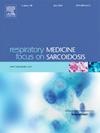抗炎药对慢性阻塞性肺病的治疗作用?
IF 3.1
3区 医学
Q2 CARDIAC & CARDIOVASCULAR SYSTEMS
引用次数: 0
摘要
慢性阻塞性肺疾病(COPD)仍然是全球发病率和死亡率的主要原因。其主要特征是持续的呼吸道症状和进行性气流限制,这两者都是由慢性炎症驱动的。尽管使用了最大限度的支气管扩张和吸入皮质类固醇(ICS),但目前的治疗既不能阻止疾病进展,也不能防止恶化和肺功能丧失。最近的研究重点是开发针对COPD发病机制中涉及的特定途径的新型抗炎药,旨在提供症状缓解之外的疾病改善作用。其中,吸入式磷酸二酯酶4 (PDE4)抑制剂,特别是双PDE3/4抑制剂,如ensifentrine,已经显示出有希望的抗炎和支气管扩张作用,ensifentrine最近被添加到我们的治疗选择库中。此外,针对2型炎症的生物疗法,特别是针对白细胞介素-5 (IL-5)和白细胞介素-4/13 (IL-4/13)途径的单克隆抗体(mab),已显示出减少嗜酸性COPD患者恶化的疗效。Dupilumab是一种靶向IL-4/13的单抗,是首个正式批准用于COPD的生物制剂。其他正在研究的策略包括Janus激酶(JAK)和丝裂原活化蛋白激酶(MAPK)抑制剂,趋化因子受体拮抗剂和靶向炎症细胞产物的药物,如基质金属蛋白酶(MMPs)和中性粒细胞弹性酶。虽然一些新化合物未能证明临床益处或因无效而停产,但不断发展的治疗前景强调了基于炎症表型的个性化方法的重要性。正在进行的和未来的试验可以阐明这些创新药物在改善COPD患者预后方面的作用,并可能重塑标准的管理范式。本文章由计算机程序翻译,如有差异,请以英文原文为准。
Anti-inflammatory agents for the management of COPD - Quo Vadis?
Chronic obstructive pulmonary disease (COPD) remains a leading cause of morbidity and mortality around the globe. Its main characteristics are persistent respiratory symptoms and progressive airflow limitation, both of which are driven by chronic inflammation. Despite the use of maximum bronchodilation and in selected patients inhaled corticosteroids (ICS), current therapies neither halt disease progression nor prevent exacerbations and loss of lung function.
Recent research has focused on developing novel anti-inflammatory agents targeting specific pathways implicated in COPD pathogenesis, aiming to provide disease-modifying effects beyond symptomatic relief. Among these, inhaled phosphodiesterase 4 (PDE4) inhibitors and especially dual PDE3/4 inhibitors like ensifentrine have demonstrated promising anti-inflammatory and bronchodilator effects, with ensifentrine recently being added in our arsenal of treatment options. Additionally, biologic therapies targeting type 2 inflammation, particularly monoclonal antibodies (mAbs) focusing on interleukin-5 (IL-5) and interleukin-4/13 (IL-4/13) pathways have shown efficacy in reducing exacerbations in patients with eosinophilic COPD. Dupilumab, a mAb targeting IL-4/13, is the first biologic officially approved for COPD.
Other strategies under investigation include Janus kinase (JAK) and mitogen-activated protein kinase (MAPK) inhibitors, chemokine receptor antagonists and agents targeting products of inflammatory cells such as matrix metalloproteinases (MMPs) and neutrophil elastase. While some novel compounds have failed to demonstrate clinical benefit or were discontinued due to futility, the constantly evolving therapeutic landscape highlights the importance of a personalized approach, based on inflammatory phenotypes. Ongoing and future trials could elucidate the role of these innovative agents in improving outcomes for COPD patients and may reshape standard management paradigms.
求助全文
通过发布文献求助,成功后即可免费获取论文全文。
去求助
来源期刊

Respiratory medicine
医学-呼吸系统
CiteScore
7.50
自引率
0.00%
发文量
199
审稿时长
38 days
期刊介绍:
Respiratory Medicine is an internationally-renowned journal devoted to the rapid publication of clinically-relevant respiratory medicine research. It combines cutting-edge original research with state-of-the-art reviews dealing with all aspects of respiratory diseases and therapeutic interventions. Topics include adult and paediatric medicine, epidemiology, immunology and cell biology, physiology, occupational disorders, and the role of allergens and pollutants.
Respiratory Medicine is increasingly the journal of choice for publication of phased trial work, commenting on effectiveness, dosage and methods of action.
 求助内容:
求助内容: 应助结果提醒方式:
应助结果提醒方式:


